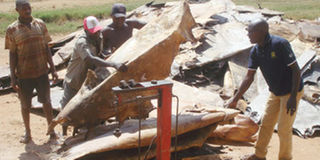Leather sector limps despite State bid to make it vibrant

Weighing hides and skins. About 30 per cent of hides and skins produced in Tanzania reach the market while the bulk of the production are exported in raw form. PHOTO | FILE
What you need to know:
With an estimated population of 21.3 million cattle, 15 million goats and 6.4 million sheep, it is surprising that Tanzania’s leather industry is still in a shambles - counting little in terms of job creation and poverty alleviation.
Dar es Salaam. The government’s ambitious plan to streamline local the leather sector and increase its contribution to the national economy is not paying off, The Citizen can reveal.
Tanzania has huge potential of becoming a giant exporter of leather products and boost the sector’s contributions to the economy should a conducive business environment be created.
With an estimated population of 21.3 million cattle, 15 million goats and 6.4 million sheep, it is surprising that Tanzania’s leather industry is still in a shambles - counting little in terms of job creation and poverty alleviation.
Investigations done by this paper show that before July last year About 30 per cent of hides and skins produced in Tanzania reached the market while the bulk of the production were exported as raw stock for processing abroad.The potential annual hides and skins production, according to government records, amount to about 3.8 million bovine hides, 2.4 million goatskins and 2.2 million sheepskins.
Hides and skins collections average less than 50 percent of potential slaughter; that is: 2.4 million cattle hides, 900,000 goat skins and 400,000 sheepskins.
But the situation has worsened since the government increased export tax on raw hides and skins from 40 percent to 90 percent to encourage value addition in the 2012/2013 budget.
Presenting the 2012/2013 budget estimates in Dodoma last year, minister for Finance, Dr William Mgimwa told the parliament that the government decided to increase the levy in effort to discourage exportation of the animal products.
He said it was the government’s intention to create a situation where local tanneries would access raw materials.
Since implementation of the new levy in July last year, incidences of smuggling are said to be increasing as premium prices offered in the neighbouring countries are said to fuel the malpractice thus creating an acute shortage of raw materials for the local factories.
A survey conducted by the ministry after the increase in levy has proved this. “Small traders who were vending raw hides and skins to the domestic processors have stopped particularly after the government increased export levies on the products,” said Mr Emmanuel Muyinga from the ministry of Livestock Development and Fisheries.
Consequently, the quality of raw leather products and revenues is declining. He said the findings revealed that most local factories receive raw hides and skins of very low grades instead of the highest grade of Tannery Run (TR) that used to be supplied prior to the increment of levy.
“It is currently unknown with whom they trade .” he said, adding that some reports indicate that all high quality leather products are being smuggled to neighbouring countries leaving those of inferior value for the domestic factories.
Statistics show that a massive smuggling of raw hides and skins to neighbouring countries, cost the government over Sh1 billion annually.
According to a reliable source, who did not want to be named, at least 50,000 hides per month cross the border to neighbouring countries, thus denying the government money in export levy of over Sh 427million.
The Permanent Secretary in the ministry of Industry and Trade, Ms Joyce Mapunjo acknowledged that the government was losing a lot of revenue, through tax evasion as some greedy business persons provide wrong export figures.
“Such businesses quote low export prices and volumes of the cargo to evade paying the right amount of tax to the government,” she stressed, declining to state the exact figure.
She said the government has been supporting traders in the local leather products, citing the decision to hike the export levy to 90 per cent from 40 per cent as a move to discourage trading in raw hides and skins
This would in return, according to the permanent secretary, foster domestic industrialisation. But most tanneries in the country may close soon due to lack of materials.
The tanneries include Moshi Leather Industries, Tanzania Leather Industries, Afro Leather, Kibaha Tannery, Himo Tanners and Salex Tanners – which can process 40 square feet of leather.
Most of these factories, as of now, operate at below 30 per cent, and hope that the government can announce positive incentives during the ongoing budget session in Dodoma.
The Confederation of Tanzania Industries (CTI)’s director for Policy and Advocacy, Hussein Kamote, commenting on the matter said, the leather sector which lags behind could offer employment to many Tanzanian youths.
He said it is only through increased industrial production that developing countries can increase job employments, thus the need to fully revamp leather industries in the country.
“It is only unfortunate that Tanzania has failed to tap the great income within the leather sector, which if well coordinated will guarantee new jobs” said Mr. Kamote.
Speaking with The Citizen this week, Tanzania Tanneries Association Chairman, Onorato Garavagli, said the situation has worsened compared to how it was before the government increased the levy.
“It is no longer good business any more, all tanneries are experiencing hard time due to lack of materials, and may close down anytime from now”he said.
The director for Industry Development in the ministry of Industry and Trade, Ms Eline Sikazwe, told this paper that there are plans to improve the local leather sector.
She said the focus will be on increasing value addition into the raw leather products, saying doing so will see the sector’s development and contribution to economic growth increased.
“The government has been wasting massive revenues from exporting raw hides and skins, but it is now time to transform the subsector to explore its profitability,” she said.
Low investments in value addition is said to have denied the nation huge revenues as nearly 90 per cent of hides and skins are exported in their raw form.




